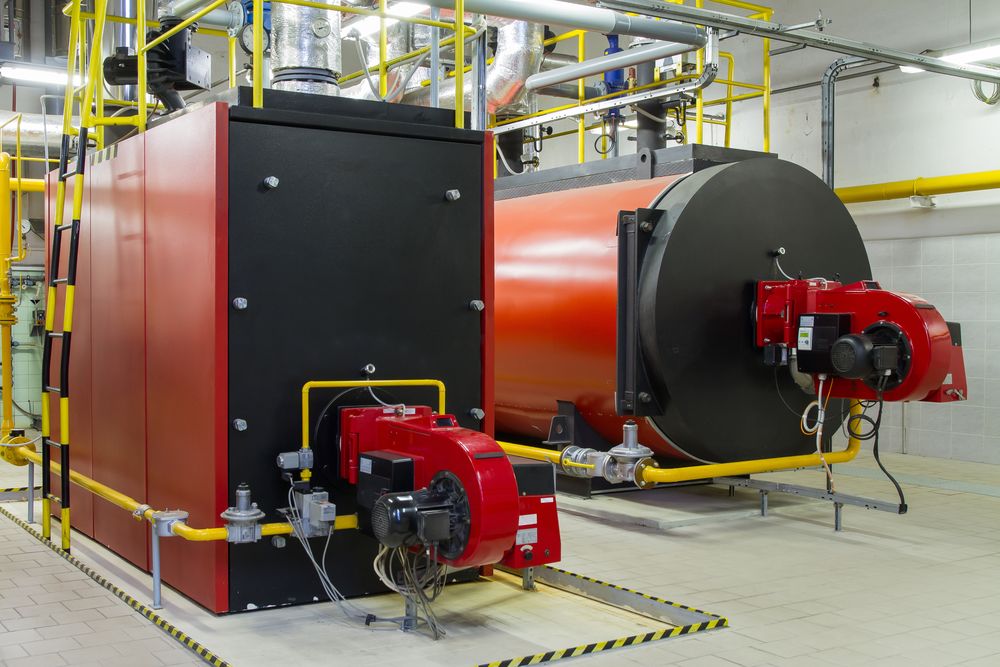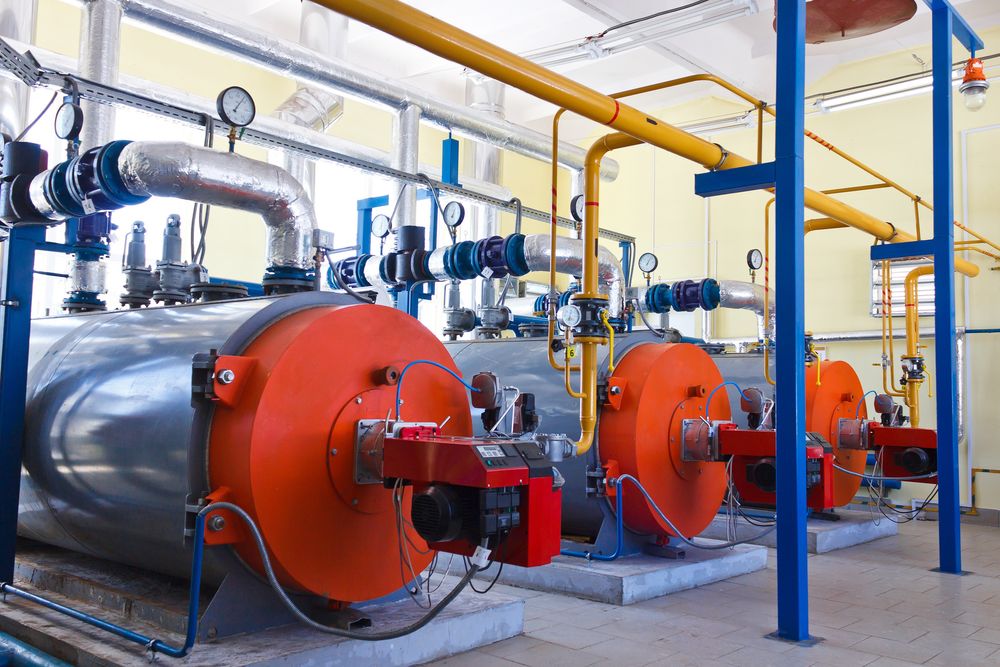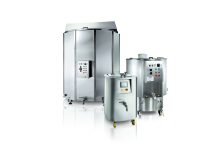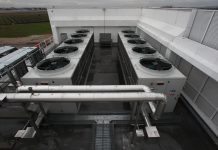
Industrial food processes applying heat at one or more stages are the vast majority: heat is still one of the most widespread means to reduce or virtually eliminate microbiological risk in food. Furthermore, heat is needed to cook food and thus to render it softer, smoother, more digestible and in general more appetizing. Heat is also needed for many other operations, as sanitation of packaging at pre-filling stage, pasteurization or sterilization of packaged food, cleaning and sanitation procedures of equipments, surfaces and food plant in general. Heat is often delivered via hot water, usually produced by boilers. Boilers are two-phase-flow heat exchange equipments: on one side is a boiling fluid, on the other side is either a single-phase or two-phase flow. If the equipment is such to provoke water phase change from liquid to vapor in a controlled and continuous way, it is also defined as “steam generator”. Hot water/steam produced by boilers is usually forced into heat exchangers, devices in which heat is transferred from a hot fluid to a cold fluid/mass commonly through a thin separating wall that can take on a wide variety of geometries: metal structures as pipes (shell and tube, multitube, double pipe or pipe-in-pipe exchangers, etc.) or plates (gasketed plates or matrix and plate fin-tube exchangers, etc.), in order to indirectly contact the food/beverage and transfer heat to it. Less commonly the heat exchange is not through a metal wall and there is direct contact between hot water/steam and food/liquid, i.e. uperization processes for milk treatment. In this particular example, heated water quality must be food grade; in all other cases (no direct food/beverage contact), feed-water microbiological quality is not paramount but other parameters are, as mineral content, in order to prevent fouling. Fouling is the accumulation of undesirable substances on a surface, and can rapidly diminish heat exchange efficiency and increased pressure drop in boiler equipments, especially in presence of an high surface area to water quantity ratio. Fouling of heat transfer surfaces introduces one of the major uncertainty factors into the design and operation of boilers.
Boiler structure main features are:
– Burner/furnace: is the organ where fuel providing thermal energy is entered and combusted. A nearly stoichiometrical mixture of fuel carbon content and atmospheric oxygen is feeding a flame that diffuse heat through thermal convection and irradiation to the boiler tank.
– Tank/evaporator: it contains the liquid (usually water) which is heated by the burner/furnace up to evaporating temperature.
– Superheater: is an important boiler accessory aimed at improving efficiency, converting saturated steam (or “wet” steam) into “dry” steam. Superheating normally refers to the process of increasing the temperature of steam above 200°C and 15 bar to give extra heat to steam in order to increase its temperature without increasing pressure and thus to produce a very dry steam. This feature is most common in large industrial plants, but superheaters are applicable also to low pressure boilers. Superheaters can use radiant or convection heating, or be separately fired.
– Economizer: to reduce fuel wastage, residual heat (e.g. heat trapped into boiler
exhausts) is recuperated through economizers. These equipments allow feed-water pre-heating up to 5°C below the saturation temperature, that is the temperature at the evaporator inlet; the difference between temperature in the economizer and temperature at the evaporator inlet is called ΔT sub-cooling, and must be >0 to avoid evaporation in the economizer, with consequent thermal stress.
– Masonry: as industrial boilers are of big dimensions, they might need appropriate supporting structure; usually there is a layer of refractory brickwork or insulating material in order to avoid heat dispersion and to protect surrounding equipments.
– Chimney: is the duct that leads boiler exhausts to the outside atmosphere. Several systems can be implemented to recuperate exhausts residual heat and also to reduce their polluting effect. Boilers can be classified (1) depending on:
Circulating medium: firetube boilers or watertube boilers if smoke or water is circulating, respectively. Firetube boilers were first on the market, but watertube boilers present some advantages: improved heat exchange surface and coefficients, better convective flow control, smaller size, faster start-up and higher safety profile. Water circulation can be natural but more often is assisted or forced. Water to surface area ratio can be big, medium, small or very small. The term “once-through boiler” refers to a special type of watertube boiler in which inlet for feed-water is at the bottom and steam is produced from the top: water flows, without recirculation, sequentially through economizer and furnace wall, and evaporates in superheating tubes.
Operating pressure: in early boilers, steam was produced at low pressure (e.g. 1 bar above atmospheric pressure); the demand for more powerful engines created a need for boilers that operated at higher pressures. Boiler units used in modern power plants can reach steam pressures above 80 bar.
Installation kind (fixed, semi fixed, mobile): most boilers are designed for continued and fixed use and are installed permanently in a rational plant point; some other boilers can be moved quite easily in different sites thanks to smaller size: they are compact and complete of all accessories; some of them also have a fuel tank.
Fuelling and energy-saving systems. A first distinction can be made based on solid fuels (e.g. timber, lignite, pellets) or liquid fuels (e.g. gas, kerosene). Boilers can also be classified into those heated directly by the combustion of fossil fuels (diesel, bituminous coal, etc.) and those heated indirectly by a hot gas or liquid that has received its heat from another energy source as biomass or biowaste (often of vegetal origin, either solid or liquid i.e. vegetal oils). The first classic kind are referred to as “fossil fuel fired boilers”, and the latter as “waste heat boilers”. A waste heat boiler can also more broadly be considered a special type of boiler that generates steam by removing the heat from a process that would have otherwise been wasted. They are therefore able to provide significant reductions in fuel and energy expenses, as well as reduce greenhouse gas emissions. Waste heat boilers may be horizontal or vertical shell boilers or water tube boilers. They would be designed to suit individual applications ranging through gases from furnaces, incinerators, gas turbines and diesel exhausts. The prime requirement is that the waste gases must contain sufficient usable heat to produce steam or hot water at the condition required. Waste heat boilers may be designed for either radiant or convective heat sources. In some cases, problems may arise due to the source of waste heat, and due consideration must be taken of this, with examples being plastic content in waste being burned in incinerators, or carry-over from some type of furnaces causing strongly bonded deposits and carbon from heavy oil fired engines. Some may be dealt with by maintaining gas-exit temperatures at a predetermined level to prevent dew point being reached, and others by soot blowing. Due to soaring energy costs, there is increasingly greater interest in onsite power generation plants including cogeneration (combined production of heat and electric power) plants which incorporate waste heat recovery technologies, and also in trigeneration plants that besides include waste heat recovery technologies as absorption chillers which generate chilled water for air-conditioning.





Hello !
We are interested in an industrial steam boiler for the production of fuel rial, waste and firewood for the extraction of oils from plants.
In that it is possible to be repaired or used with production capacity of up to 16 bar.
We ask you a price up to Lezha- Albania.
Thanks and best regards
Preng Cupi
Comments are closed.